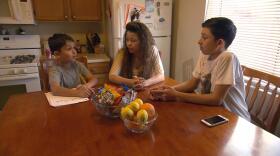Thousands of adult New Mexicans can't read well, and because of social stigmas, they’re a hidden population. The latest data estimates adult education programs only manage to reach a fraction of those folks. But an Albuquerque literacy program is developing a method of making contact with potential students.
Andrew Torres did not know how to read for most of his adult life. He also copes with depression. Just a year ago, he felt comfortable turning to his counselor for help.
"I told him, ‘If I learned how to read, it’d help me a little bit,’ " he said, "And he says, 'You know what? I’m not leaving this office today until we find some place for you.’ ”
They found a literacy program called Reading Works. The months of studying have changed everything, he said. He used to feel bad when his grandson would ask him to read to him. And now …
“I try to catch him every time he’s around the house. He tries to hide me from now, because I read to him. And I’m like, ‘You wanted me to read to you. I learned how to read. Now you’re going to listen because that’s my homework today,' ” Torres said.
Programs like Reading Works face the constant challenge of trying to connect with folks who have trouble navigating in a print-oriented world. Sometimes they can find people like Andrew through referrals.
Margaret Barker is the founder of Reading Works.
“We’ve done things like a public service announcement on television," said Barker. "We’ve have posters that are mainly pictures. But it’s still very difficult to reach those people”
Barker and project manager Esodie Geiger laughed as they talked about all the different ways they’ve connected with students in the past.
“A friend of mine told me about your organization or someone sent me here," said Geiger, repeating exchanges with students. " ‘Who sent you?’ ‘Well, they sent me!’ Isn’t that how it is? ‘And who would they be?' ”

They bank on word of mouth. Sometimes they make public service announcements. And now, Reading Works is trying out something new. They’ve made a survey that determines if someone is literate or not.
In the spring, Reading Works partnered with other local nonprofits that deal with poverty so they can use the survey to screen for literacy skills during client interviews.
“You know, until the survey, I think most people presume you graduated, you know how to read," Geiger said. "So, they wouldn’t even think to ask, because why would they have to?”
While drafting the survey, Barker said she couldn’t find any pre-existing literacy aptitude screenings. Plus, there’s a range of ability and literacy needs. So the Reading Works team based its questions on students’ experiences.
“You can’t ask someone, ‘Can you read or write?’ They’re not going to answer that question," said Barker. "So you need to think of behaviors, like: Do you fill out the forms at the doctor’s office? Can you read your medicine labels? Do you avoid reading in public? Things like that.”
Barker said when their partnering nonprofits screen enough clients, Reading Works will be able to collect updated and accurate statistics about literacy levels in New Mexico. And of course, meet with more potential students.
Tracy Sharp is the director of Saranam, a nonprofit that provides apartments and education to the homeless. She said the survey will help her organization, too. “I can think off the top of my head a few of our clients that we’ve had in the past that a screening like that might have helped us find their place quicker," she said, "rather than spinning wheels, doing things they were not ready to do.”
Sharp said she will be using the Reading Works’ literacy survey in August when interviewing clients.
"I mean, reading and literacy such an important part of kind of get out poverty," she said, "which is our goal.”
Sharp said low levels of literacy and poverty go hand in hand. So, when nonprofits are able to use each another to offer an education to folks, they improve life conditions for families.
And it all starts with learning how to read.
*****
Visit New Mexico Coalition for Literacy's program directory for a list of programs statewide. An interactive map of literacy programs and literacy rates by county at publichealthnm.org.
Or call: 505-982-3997.




